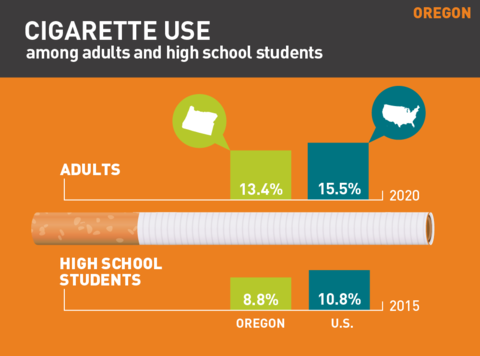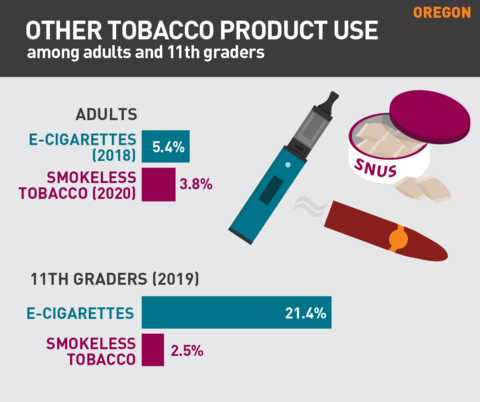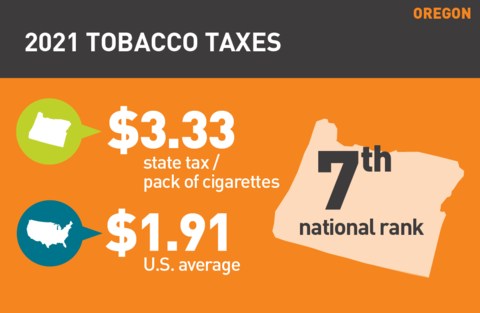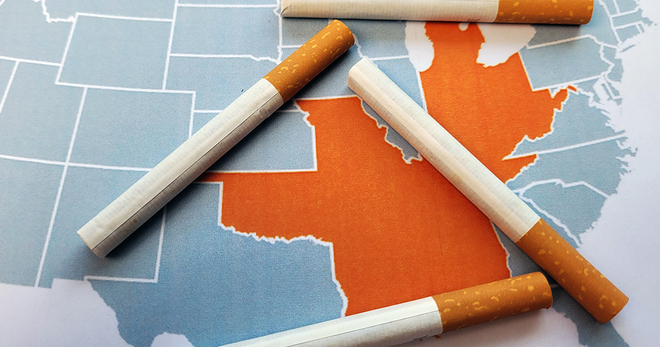Tobacco use in Oregon 2021
Cigarette use: Oregon
Cigarette smoking rates in Oregon
- In 2020, 13.4% of adults smoked. Nationally, the rate was 15.5%.1
- In 2015, 8.8% of high school students in Oregon smoked cigarettes on at least one day in the past 30 days. Nationally, the rate was 10.8% in 2015.2
Other tobacco product use: Oregon
Vaping rates in Oregon
- In 2018, 5.4% of adults in Oregon used e-cigarettes. 3
- In 2020, 3.8% of adults in Oregon used smokeless tobacco.3
- In 2019, 21.4% of 11th graders in Oregon used electronic vapor products on at least one day in the past 30 days.4
- In 2019, 2.5% of 11th graders in Oregon used chewing tobacco, snuff or dip on at least one day in the past 30 days.4
- In 2019, 2.7% of 11th graders in Oregon smoked little cigars on at least one day in the past 30 days.4
- In 2019, 1.3% of 11th graders in Oregon smoked large cigars on at least one day in the past 30 days.4
Economics of tobacco use and tobacco control
Oregon cigarette tax
- Oregon received $390.5million (estimated) in revenue from tobacco settlement payments and taxes in fiscal year 2021.5
- Of this, the state allocated $9.4 million in state funds to tobacco prevention in fiscal year 2021, 23.9% of the Centers for Disease Control and Prevention’s annual spending target.5
- Smoking-caused health care costs: $1.54 billion per year.5
- Smoking-caused losses in productivity: $1.37 billion per year.6
Oregon tobacco laws
Oregon smoking laws
Tobacco taxes
- Oregon is ranked 7th in the U.S. for its cigarette tax of $3.33 per pack (enacted January 2021), compared to the national average of $1.91. (The District of Columbia has the highest tax at $4.50 and Missouri has the lowest at 17 cents.)7-9
- Cigars are taxed at 65% of the wholesale sales price of cigars (not to exceed 50 cents per cigar).
- Moist snuff is taxed at $1.78 per ounce, except that the minimum tax per retail container is $2.14.
- All other tobacco products are taxed at 65% of the wholesale sales price.7,8
Clean indoor air ordinances
- Smoking is prohibited in government workplaces, private workplaces, schools, childcare facilities, restaurants, bars (allowed in cigar bars), casinos/gaming establishments (tribal establishments exempt), retail stores (allowed in smoke shops) and recreational/cultural facilities.7,8
- E-cigarettes are included in the state’s clean indoor air law.10
- Use of e-cigarettes in public places, places of employment, jury rooms, at least 75% of hotel rooms, child care facilities and vehicles (while children are passengers), and within 10 feet of entrances, exits, windows or ventilation intakes of enclosed areas are prohibited (with some exceptions). 10
- Use of e-cigarettes in hospitals or within 10 feet of a doorway, window, or ventilation intake is prohibited. 10
- Use of e-cigarettes in state vehicles is prohibited.
- Use of e-cigarettes in a car while a person under the age of 18 is present is prohibited.10
Licensing laws
- Wholesalers are required to obtain a license to sell cigarettes, but a license is not required to sell other tobacco products. Retailers are not required to obtain a license to sell tobacco products.7
- A license is not required to sell e-cigarette products.10
Youth access laws
- Effective December 2019, the United States adopted a law raising the federal minimum age of sale of all tobacco products to 21. Some states have not yet raised their state minimum age of sale, however, the federal law takes precedence .
- Establishments are required to post signs stating that the sale of tobacco products to underage persons is prohibited.7
- Underage persons are prohibited from buying and possessing inhalant delivery systems, including e-cigarettes.7, 10
- The sale of inhalant delivery systems to person underage persons is prohibited. 10
- Self-service displays of inhalant delivery systems are prohibited except in locations inaccessible to persons underage persons. 10
- Vending sales of inhalant delivery systems are restricted to locations inaccessible to underage persons. 10
- Public/private schools, college, community college, university career school, technical education school, youth correction and juvenile detention facilities must prohibit possession of inhalant delivery systems by persons under age 21 present at facility or at facility-sponsored event. 10
- The sale of nicotine inhalant delivery devices and liquid nicotine containers is prohibited by medical marijuana dispensaries. 10
- Remote sales and shipment of inhalant delivery systems are restricted to distributors and retailers. 10
- Delivery sales of inhalant delivery systems require the seller to obtain a distributor’s license (and potentially a retail license), a certification from the consumer that they are at least age 21 years, verify the consumer’s age through a third-party verification system. The delivery must contain a prominent statement that sales to persons under age 21 years are illegal and that proof of age is required. 10
Quitting statistics and benefits
Quitting vaping and smoking in Oregon
- The CDC estimates 50.4% of daily adult smokers in Oregon quit smoking for one or more days in 2019.3
- In 2014, the Affordable Care Act required that Medicaid programs cover all tobacco cessation medications.8**
- Oregon’s state quit line invests $1.73 per smoker, compared to the national average of $2.28.8
- Oregon has a private insurance mandate provision for cessation.8
Notes and references
Updated August 2021
*National and state-level prevalence numbers reflect the most recent data available. This may differ across state fact sheets.
**The seven recommended cessation medications are NRT gum, NRT patch, NRT nasal spray, NRT inhaler, NRT lozenge, Varenicline (Chantix) and Bupropion (Zyban).
Fiore MC, et al. Treating Tobacco Use and Dependence: 2008 Update. Clinical Practice Guideline. Rockville, MD: US Department of Health and Human Services. Public Health Service: May 2008.
1. CDC, Behavioral Risk Factor Surveillance System, 2020.
2. CDC, Youth Risk Behavioral Surveillance System, 2015.
3. CDC, Behavioral Risk Factor Surveillance System, State Tobacco Activities Tracking and Evaluation System, 2021.
4. Oregon Healthy Teens Survey, 2019.
5. Campaign for Tobacco-Free Kids, Broken Promises to Our Children: a State-by-State Look at the 1998 State Tobacco Settlement 22 Years Later FY2021, 2020.
6. Campaign for Tobacco-Free Kids, Toll of Tobacco in the United States.
7. American Lung Association, State Legislated Actions on Tobacco Issues (SLATI).
8. American Lung Association, State of Tobacco Control, 2021.
9. Campaign for Tobacco-Free Kids. State Cigarette Excise Tax Rates & Rankings. https://www.tobaccofreekids.org/assets/factsheets/0097.pdf. Accessed.
10. Public Health Law Center. U.S. E-Cigarette Regulation: 50-State Review. http://www.publichealthlawcenter.org/resources/us-e-cigarette-regulations-50-state-review. Accessed.
More in smoking by region
Want support quitting? Join EX Program
By clicking JOIN, you agree to the Terms, Text Message Terms and Privacy Policy.
Msg&Data rates may apply; msgs are automated.





